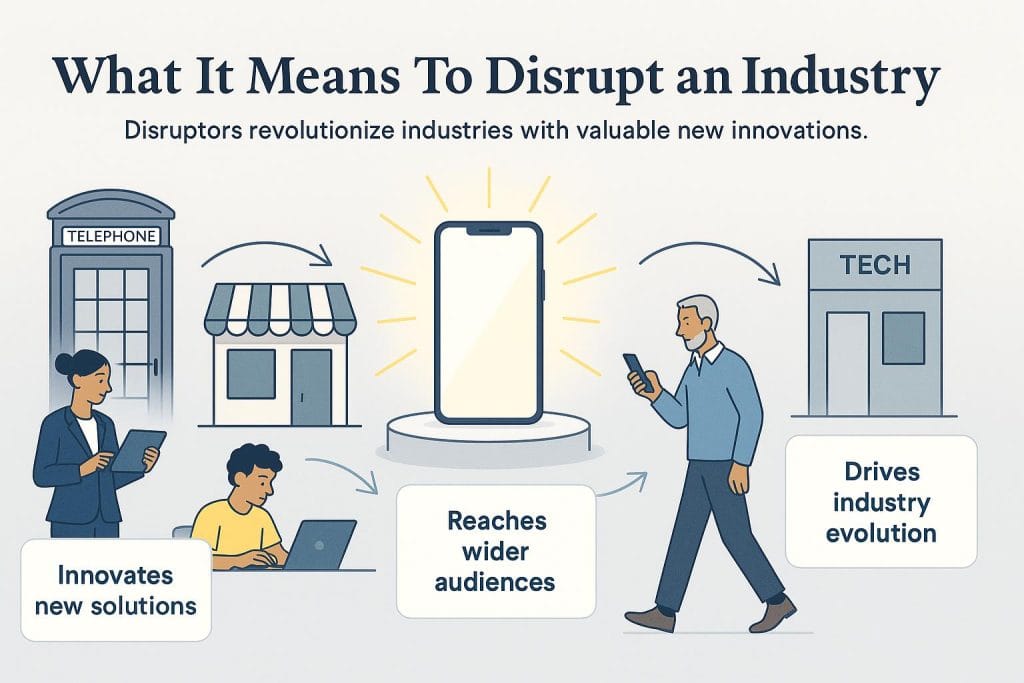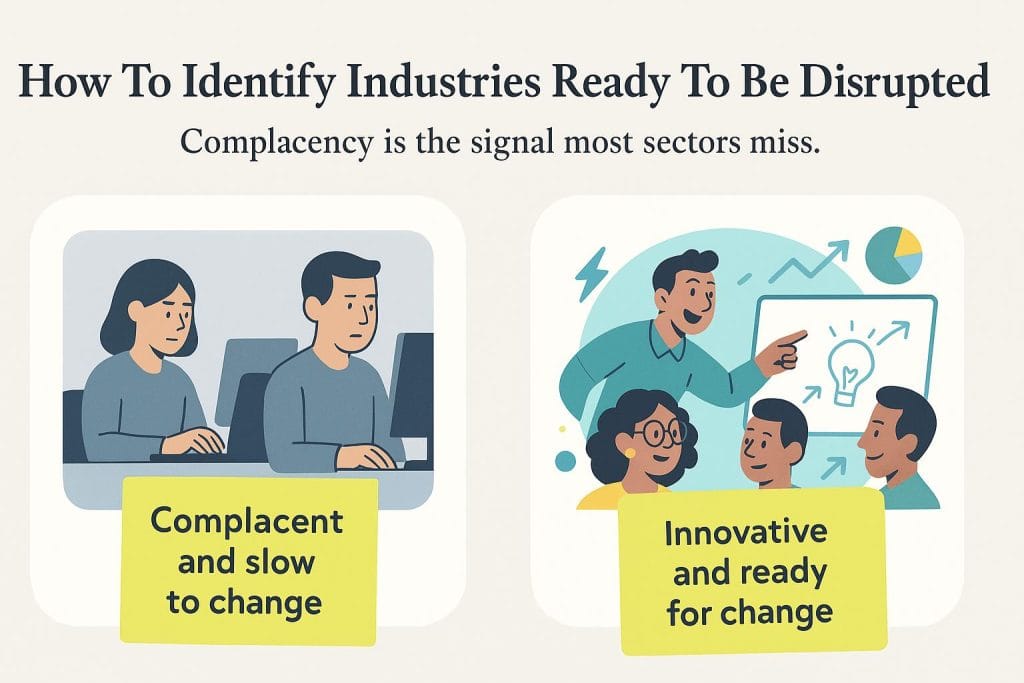Business.com aims to help business owners make informed decisions to support and grow their companies. We research and recommend products and services suitable for various business types, investing thousands of hours each year in this process.
As a business, we need to generate revenue to sustain our content. We have financial relationships with some companies we cover, earning commissions when readers purchase from our partners or share information about their needs. These relationships do not dictate our advice and recommendations. Our editorial team independently evaluates and recommends products and services based on their research and expertise. Learn more about our process and partners here.
How to Identify Industries That Are Ready for Disruption
Some of the most successful startups in recent years have seen rapid growth by shaking up their respective industries.

Table of Contents
Some of the most successful companies of today were yesterday’s disruptors. Entrepreneurs who are able to develop new ways of doing things can turn entire industries upside down and emerge as the market leaders of tomorrow. The pace of technological development has only made disruption a more viable approach, even for small businesses. The trick is identifying an opportunity and seizing it.
What does disruption mean?

Before we dive into which industries are being disrupted, let’s explain what we mean by disrupting. To cause disruption, a company must create innovations that change an industry at its core and add value to the market.
Perhaps the most famous example of disruption is the emergence of Uber, the first household name ridesharing company to disrupt the taxi business. Uber first came on the scene in 2009, and less than 20 years later it’s a dominant force with a market cap of $202 billion — that’s the power of disruption.
Oftentimes, disruption goes hand-in-hand with digitization. According to McKinsey research, companies that embrace digital innovation grow faster in terms of revenue and productivity than competitors that resist digital innovation. Digital adopters tend to improve profit margins three times as fast as the average company and are primed to disrupt their sector.
How to identify industries ready for disruption

Many entrepreneurs hope to discover industries to disrupt. But how do you recognize an industry that’s ready to be shaken up? If it were easy to decipher, every business owner would enter the market and catapult to the top. However, there are a few general signs that a sector is ready for disruption.
Market complacency
Complacency in the marketplace is one of the biggest signs that something needs to change. For existing businesses in any given industry, complacency should be viewed as a troubling indicator that disruption is approaching.
A good example is the cable industry, which became complacent and opened the door to streaming platforms. Companies like Netflix and Hulu have now taken a healthy share of the market, offering relatively low-cost ad-free options for on-demand service.
Customer frustration
As consumers become frustrated with products and services, they voice their opinions, tighten their wallets and look for alternatives. This is where savvy entrepreneurs recognize an issue and create an alternative solution.
One example of a company that recognized customer frustration and capitalized on it is MedPro Disposal. The medical waste industry was relatively top-heavy, meaning much of the market was controlled by a single player, Stericycle. However, over the years, the medical industry became frustrated with the hefty costs of Stericycle’s services.
That’s when MedPro Disposal’s founder, George Shanine, recognized an opportunity to create a cost-effective alternative. By offering cost savings of 30 to 40 percent, Shanine disrupted the industry and took away a sizable share from Stericycle. [Learn how to use customer feedback to gain a competitive advantage.]
Tension points vs. pain points
According to Luke Williams, author of Disrupt: Think the Unthinkable to Spark Transformation in Your Business (FT Press, 2010), the key to identifying markets that are ripe for disruption is to look for tension points instead of massive pain points.
What’s the difference? Williams believes that tension points are much more subtle. They aren’t typically big enough to be considered major problems, which means most businesses aren’t paying attention to them. However, once a solution is developed, it’s obvious that fixing the underlying issue offers an excellent opportunity to penetrate and revolutionize the industry.
Market concentration
An industry or market that is dominated by a few companies is the perfect space for disruption. Due to the imbalance of power within the industry, it may seem difficult to break through the power structure and disrupt it.
However, startups often can work faster, adopt more efficient technologies into their processes, and develop innovative products or services more quickly than the businesses at the top. They can find space to move up in the industry and begin to shake things up, causing the dominating companies to either shift or crumble.
>> Learn more: At What Point Are You No Longer a Startup?
Technological lag
Because technology is constantly evolving, industries must stay on top of technological changes and implement the latest tools — or risk disruption. A lot of massive companies use complex systems, so it can be hard for them to transition to new tech quickly.
This is what makes those businesses perfect targets for disruption: There’s a chance for others to give customers easier access to products and services that benefit them. For example, businesses that are ready to shake things up might implement mobile apps, self-service options and other innovations that use newer technology.
The Disruption Opportunity Matrix
Use this analytical tool to prioritize industries ripe for disruption based on two key dimensions: market accessibility and disruption potential.
Market Accessibility | High Disruption Potential | Low Disruption Potential |
|---|---|---|
High Accessibility | Prime targets for disruption | Competitive markets |
Low Accessibility | Long-term opportunities | Avoid |
Consider the following factors to gauge market accessibility of the industry you’re targeting:
- Capital requirements for entry
- Regulatory barriers
- Technical complexity
- Customer acquisition difficulty
Consider the following factors to gauge disruption potential of the industry you’re targeting:
- Level of customer dissatisfaction
- Technological advancement opportunities
- Market concentration
- Innovation stagnation
Industry Disruption Assessment Checklist
Use this systematic approach to evaluate any industry’s vulnerability to disruption.
Market Structure Analysis
- Is the industry dominated by three to five major players?
- Are profit margins consistently high across incumbents?
- Has pricing remained stable or increased over the past five years?
- Are customer switching costs artificially high?
Customer Experience Evaluation
- Do customers frequently complain about the same issues?
- Are there significant unmet needs in the market?
- Is the customer journey complex or frustrating?
- Are there underserved customer segments?
Technology Integration Assessment
- Are incumbents slow to adopt new technologies?
- Do legacy systems create operational inefficiencies?
- Are there emerging technologies that could simplify the industry?
- Is digitalization lagging compared to other industries?
Regulatory Environment Review
- Are regulations creating barriers to innovation?
- Are there regulatory changes on the horizon?
- Do compliance costs disproportionately affect smaller players?
- Are there geographic markets with different regulatory approaches?
Theoretical frameworks of disruption
Foundational Disruption Theory
Clayton Christensen’s foundational disruption theory describes a process by which a product or service powered by technology initially takes root in simple applications at the low end of a market. This product or service is typically less expensive and more accessible than established alternatives and relentlessly moves upmarket, displacing established competitors.
The theory distinguishes between two types of disruption:
- Low-end disruption occurs when new entrants target overserved customers at the bottom of the market with simpler, more affordable alternatives. Low-end disruption refers to businesses that come in at the bottom of the market and serve customers in a new way. A good example of low-end disruption is budget airlines, which offer cheap fares and basic services.
- New-market disruption creates entirely new categories of consumers by targeting non-consumption. New-market disruption refers to businesses that create new spaces, or fundamentally remake existing ones. An example of new market disruption is the emergence of ridesharing companies like Uber or streaming platforms like Netflix.
Blue Ocean Strategy
Blue Ocean Strategy complements disruption theory by focusing on creating uncontested market space. A “blue ocean” is any industry that does not exist today; it is the unknown market space, untainted by competition. In blue oceans, demand is created rather than fought over.
Blue Ocean Strategy is the simultaneous pursuit of differentiation and low cost to open up a new market space and create new demand. It is about creating and capturing uncontested market space, thereby making the competition irrelevant.
Industry reports and market analysis
Major consulting firms are tracking emerging sectors with significant disruption opportunities. Research from McKinsey Global Institute has pinpointed 18 key industries positioned to become major competitive battlegrounds over the next two decades. These high-growth sectors—spanning AI software and services, cybersecurity, air mobility, obesity drugs, and industrial biotechnology—are projected to expand their share of global economic output from the current 4 percent to between 10 and 16 percent by 2040.
Recent business surveys indicate that disruption has become a permanent fixture in corporate strategy. A comprehensive study by AlixPartners and Potloc examined responses from 3,100 senior executives spanning 11 countries for their 5th Annual Disruption Index. The findings demonstrate that organizational leaders now view market disruption as an ongoing reality rather than an occasional challenge.
Technology research from Gartner points to transformative changes in workplace automation and human augmentation. According to their 2025 strategic technology outlook, autonomous AI systems are expected to handle 15 percent of routine workplace decisions by 2028, representing a dramatic shift from zero automation in 2024. Looking further ahead, Gartner forecasts that nearly one-third of knowledge workers will rely on brain-machine interface technologies by 2030 to maintain competitiveness alongside AI systems, up from virtually no adoption today.
The path forward for entrepreneurs
For an entrepreneur, disrupting an existing industry is a very challenging proposition. It requires a clear understanding of what you’re looking for, including market complacency. Industries that have stopped innovating are almost always due for a shake-up.
The key success factors for disruption include:
- Deep Market Understanding: Invest time in understanding customer needs, industry dynamics, and competitive landscape
- Technology Leverage: Identify how emerging technologies can create new value propositions
- Agile Execution: Maintain flexibility to adapt strategy based on market feedback
- Financial Patience: Disruption often requires longer time horizons than traditional business models
- Regulatory Awareness: Understand and plan for regulatory responses to your innovation
Once you identify an industry that is experiencing one or more of these characteristics, you can begin to think about disruption.
The next wave of disruption is already emerging. Companies experimented boldly in 2024, catalyzed by generative AI. In 2025, leaders look to turn lessons into profits. For entrepreneurs willing to challenge conventional wisdom and apply systematic analytical frameworks, the opportunities for meaningful disruption are many. The key is combining theoretical understanding with practical assessment tools to identify the right opportunity at the right time.
Anna Johansson contributed to this article.





